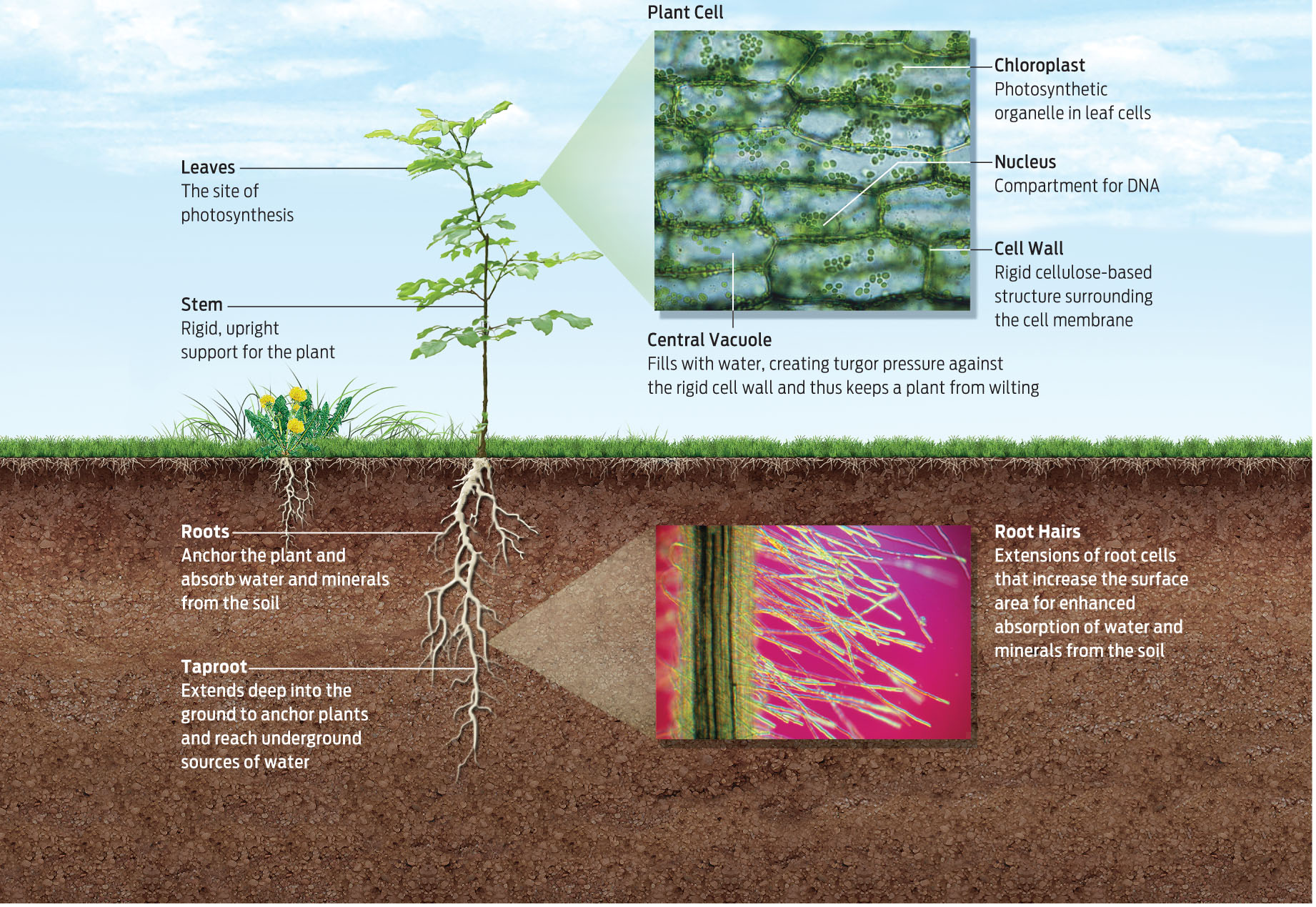Plant Structure
 How do plants stand up?
How do plants stand up?
ROOT SYSTEM The belowground parts of a plant, which anchor it and absorb water and nutrients.
SHOOT SYSTEM The aboveground parts of a plant, including the stem and photosynthetic leaves.
ANSWER: From tiny 3-inch-tall crocus flowers to massive redwood trees standing 300 feet, plants come in a variety of shapes and sizes. Yet almost all of them share the same basic design: a belowground root system for absorbing water and nutrients and an aboveground shoot system made up of stems and leaves. This body arrangement works well for plants, allowing them to simultaneously reach for the sky and anchor themselves safely in the soil—all without the help of bones, tendons, or muscles. In the absence of such a musculoskeletal system, what keeps a plant from flopping over?
CELL WALL A rigid layer surrounding the cell membrane of some cells, providing shape and structure. In plant cells, the cell wall is made of cellulose, a complex carbohydrate.
CHLOROPLAST The organelle in plant cells in which photosynthesis takes place.
Like animals and other eukaryotes, plants are made of cells packed with organelles, including a nucleus, endoplasmic reticulum, and mitochondria. Plant cells contain a few plant-specific parts as well, including a supportive cell wall, made of a complex carbohydrate called cellulose; chloroplasts, the sites of photosynthesis; and a central vacuole, essentially a large water balloon occupying the center of the cell. When filled with water, vacuoles create turgor pressure against the cell wall, keeping a plant body rigid and upright. When the vacuoles are less than full, turgor pressure is reduced, and the plant wilts.
CENTRAL VACUOLE A fluid-filled compartment in plant cells that contributes to cell rigidity by exerting turgor pressure against the cell wall.
TURGOR PRESSURE The pressure exerted by the water-filled central vacuole against the plant cell wall, giving a stem its rigidity.
LIGNIN A stiff strengthening agent found in secondary cell walls of plants.
Cell walls contribute to a plant’s stiffness in another way. Plant cells are packed tightly together, much like bricks in a wall; carbohydrate molecules associated with the cell walls act like glue, helping adjacent cells stick together. With many cells held together in this way, plant tissues are exceptionally strong, which is why they make such durable ropes and fabrics.
Some plant tissues, such as those that make up the stem, are made of cells with two cell walls: an outer cell wall containing cellulose, and a second, inner cell wall containing cellulose and lignin. Lignin is a hard, durable material, which lends added support and strength to plant tissues; it is what makes them “woody.” A plant with a thick, woody stem (or trunk, in the case of a tree) can grow tall and still not topple over. The tallest plants on Earth are the California redwoods (Sequoia sempervirens), which can reach heights of more than 350 feet.
The tallest plants on Earth are the California redwoods (Sequoia sempervirens), which can reach heights of more than 350 feet.
ROOT HAIRS Tiny extensions of root cells that increase the surface area of roots and enhance their ability to absorb water and nutrients.
TAPROOT A long, straight root produced by some plants that stores water and carbohydrates.
Plants would not be able to grow so tall were it not for the extensive system of roots that anchors them in the ground. Some plants have root systems that are much deeper than the plants are tall, and some plants’ roots extend out horizontally to about three times the branch spread. A vast number of tiny root hairs increase the surface area of the root, enhancing its ability to absorb water and nutrients from the soil. When root hairs are included, a plant’s total root length can be hundreds of miles long. In addition, some plants produce very long taproots—deep-reaching roots that help the plant reach the underground water table. Taproots also store water and carbohydrates for the plant, making them appealing and nutritious to animals. Carrots and turnips are actually taproots (INFOGRAPHIC 32.1).
Trees and other plants are anchored in the soil by a root system and extend their shoot system, including stems and leaves, skyward. A variety of features, including rigid cell walls and a central vacuole, allow the stems to remain upright.
